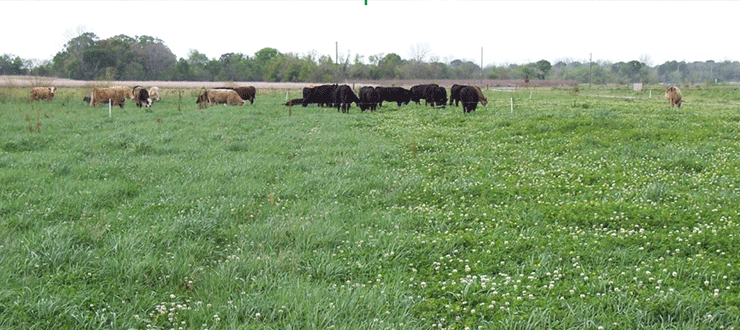
THE CASE FOR FORAGE LEGUMES
For decades, forage legumes such as clovers, vetches, alfalfa, and lespedezas have been considered to be special and beneficial pasture plants. In recent years, incentives for livestock producers to grow them, usually as a companion to forage grasses, have further increased. Why are many people more interested than ever in growing legumes? Here are several compelling reasons.
Lower Nitrogen Fertilizer Costs.
The increased cost of nitrogen fertilizer is probably the main factor stimulating more interest. Legumes have the ability to obtain nitrogen from the atmosphere and “fix” it in nodules on their roots. The amount of nitrogen fixed varies depending on species, stand density, and other factors, but can be substantial. For example, numerous studies have shown that nitrogen fixation/acre/year for a stand of annual clover(s), white clover, and red clover often is within the range of 60 to 150, 100 to 150, and 150 to 200, respectively. Nitrogen fixation alone usually pays for the cost of planting a legume.
Better Forage Quality.
The forage quality of legumes is generally higher than that of most forage grasses. Legumes are usually higher in crude protein, digestibility, and many minerals and vitamins. The result is better performance of grazing animals in terms of higher gains and higher reproductive rates.
Better Distribution of Growth.
The introduction of legumes into grass pastures often extends the grazing season. Red clover is especially likely to provide additional summer production when grown with cool season perennial grasses. Overseeding a cool season annual legume on a warm season perennial grass pasture permits production of quality feed during winter and early spring when such pastures would otherwise be unproductive.
Increased Forge Yield.
The forage yield per acre from a grass/legume mixture is usually higher than that of grass alone. For example, in a multi-year Kentucky study, red clover grown with tall fescue produced a higher yield than tall fescue fertilized with 180 pounds of nitrogen per acre. A legume/grass mixture is especially likely to increase dry matter yield as compared to grass alone that receives little or no nitrogen fertilizer.
Benefits in Crop Rotation Systems.
In addition to furnishing nitrogen for succeeding crops, clovers tend to improve soil characteristics by improving soil tilth. They also may create root channels that benefit subsequent crops grown in rotation with clovers or clover/grass mixtures.
Reduced Animal Toxicities.
Legumes can play an important role in offsetting various livestock disorders. Surveys have shown that that growing legumes with tall fescue is the number one strategy used by beef cow-calf producers to increase performance of animals suffering from fescue toxicity caused by toxic-endophyte tall fescue. Furthermore, the likelihood of grass tetany is reduced by the presence of clovers in animals’ diets. The reason is that this disorder is caused by magnesium deficiency and legumes contain more magnesium than grasses.
Environmental Acceptability.
Legumes provide homegrown slow release nitrogen, which is more environmentally friendly than commercial nitrogen. They furnish pollen and nectar for honeybees, and tend to increase populations of beneficial predatory insects. They also are highly attractive to wildlife including deer, rabbits, and game birds.
Increased Profit.
Nutrition is the primary limiting factor on most livestock farms, and legumes usually provide higher nutrition levels than grasses. Better nutrition means more milk production, higher weaning weights, and increased likelihood of high reproductive efficiency. Legumes also reduce or eliminate the requirement to apply nitrogen fertilizer, which typically accounts for 20 to 40% of the cost of producing forage from grasses.
Conclusion.
The use of legumes in forage programs has numerous potential benefits. When they are present, animal performance goes up while expenses go down. Legumes are truly sustainable plants. Research results, farmer experience, and many demonstrations have clearly shown legumes to be agronomically sound, environmentally friendly, and economically advantageous.
Foraging Ahead is a column presented by Ragan & Massey and written by Dr. Don Ball, Professor Emeritus at Auburn University. Dr. Ball is one of the authors of the popular book “Southern Forages,” which can be found via a computer search that uses the words, “Southern Forages, The Fertilizer Institute.”